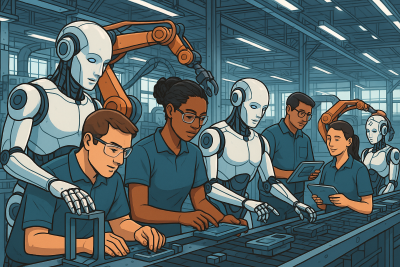Can AI innovations achieve “unbounded” productivity for society?
 By Eli Fathi and Peter K. MacKinnon
By Eli Fathi and Peter K. MacKinnon
.jpg)
_thumbnail%20.jpg)
(Image at left prompted by Peter MacKinnon and art generated by ChatGPT).
Larry Page, co-founder of Google, believes that innovation must generate at least a tenfold multiplier to achieve an exponential moonshot improvement to stay ahead and soundly surpass the competition.
Many innovations in history have achieved just such tenfold improvements with profound effect on the daily lives of people.
The mobile phone created anywhere, anytime connectivity and the internet removed borders, shrinking distance and time to virtually instantaneous anywhere in the world. These were accomplished with a dramatic reduction in transactional cost.
The accrued benefits in terms of health, safety and enjoyment to the lives of people due to innovations are obvious and extensive (for example, lighting a room with a light bulb instead of burning oil). History has demonstrated that previous innovations tend to yield a net gain in both employment and productivity.
One of the key promises of artificial intelligence-based systems is that they can change the way we work and interact while reaching at some point in the future levels of unbounded productivity (essentially limitless when using only machines to perform tasks).
The baseline for an AI system is one that can observe/sense variability in its surrounding environment and initiate appropriate responses.
For example, the Netflix recommendation system suggests movies to view based on one’s watching history that may change with time.
Next level up in sophistication is a narrow AI intelligence system dedicated to doing a niche task. It follows a set of predefined rules to solve a specific problem and can reach or surpass the capabilities of humans.
In a medical application, an AI system reading and analyzing an unlimited number of X-ray files can offer comprehensive diagnostic results as good as an experienced radiologist.
There is no dispute that generative artificial intelligence (GAI) has achieved at least a tenfold exponential increase in capabilities over previous AI-based systems.
GAI such as OpenAI's Chat GPT and Google’s Gemini use large language models (LLMs) to ingest much of the available data on the planet by scraping the internet while offering some level of limited reasoning. These models can generate, from word prompts in many natural languages, all kinds of outputs in the form of art, music, video, text documents and computer code.
Currently, after several years of tenfold exponential growth, the path of mainstream GAI is now following an incremental progression with regular announcements such as new applications of agentic AI.
However, there are still promising areas that could experience exponential tenfold capabilities and growth with current LLM technologies. Two notable areas are in software coding and real-time robotics control systems and applications.
Sam Altman, CEO of OpenAI, recently stated that AI can make coders 10 times more proficient within the next 12 months. Arguably, this will allow software developers to focus on creativity rather than on tedious tasks of code development.
Dario Amodei, CEO of Anthropic, went further and declared that AI will write 100 percent of the code within 12 months, implying 100 percent automation. Currently, AI is writing 20 percent of Salesforce’s code.
The Pew Research Centre’s prediction for the state of AI and robotics over the next five years is that “AI and robotics will be integrated into every aspect of most people’s daily lives.” They expect impacts across the board with a notable area of application using AI and robotics to assist with the care of an aging population.
Gains from AI are currently nowhere near “unbounded” productivity
The big question is whether GAI has reached a wall on future tenfold rapid growth. LLMs have key limitations, including inadequate capacity to reason, limited knowledge/access to users' proprietary information, a tendency to hallucinate when it does not know the answer and being passive – requiring a prompt to act.
AI agents are supplanting these limitations for specific use cases by their ability to reason, act and iterate to reach the desired outcome without a user’s input beyond a prompt.
When analyzing the impact on productivity of the various generations of AI systems to date, there is a definite productivity gain (for example, one robot replaces about six people on an assembly line).
However, currently, this is nowhere near unbounded productivity. It will require a further tenfold increase in AI innovations to reach this level of productivity. Predictions are that artificial general intelligence will emerge within the next decade and will exhibit the next wave of exponential tenfold and beyond increase in innovations.
A profound change on the horizon is a world augmented by AI in an interconnected global system operating in real-time in robotic factories that remove time delay and distance from the manufacturing process.
Autonomous transportation will be a reality with robotaxi and big transport rigs driving on the highways without humans at the wheel. All areas of business and professions will be impacted creating a world powered by AI that result in an always-on world economy.
As we push the sophistication of AI-based systems, things are not all rosy. The impact on worker displacement, including knowledge workers, increases drastically. Software is “virtually free” and will encourage businesses to replace humans where possible.
However, AI is a “power hog,” especially in training LLMs, increasing significantly the demand for power generation. The world will also need to contend with the negative socioeconomic impacts of deepfakes on businesses and on the most vulnerable, less educated and financially unstable in society.
The world is rapidly racing toward an unbounded productivity gains on a road filled with immense benefits and yet fraught with many socioeconomics unknowns. The adage “Caveat Emptor,” rings true – buyer (society) beware – proceed with caution!
Eli Fathi C.M. is chair of the board at Ottawa-based MindBridge Analytics. Peter K. MacKinnon is a senior research associate in the Faculty of Engineering at the University of Ottawa, and Member IEEE-USA Artificial Intelligence Policy Committee, Washington, D.C.
R$
| Organizations: | |
| People: | |
| Topics: |
Events For Leaders in
Science, Tech, Innovation, and Policy
Discuss and learn from those in the know at our virtual and in-person events.
See Upcoming Events
You have 0 free articles remaining.
Don't miss out - start your free trial today.
Start your FREE trial Already a member? Log in
By using this website, you agree to our use of cookies. We use cookies to provide you with a great experience and to help our website run effectively in accordance with our Privacy Policy and Terms of Service.





